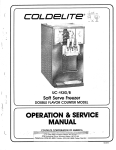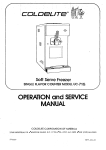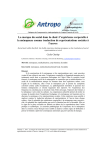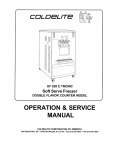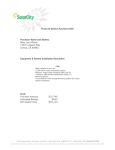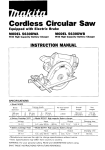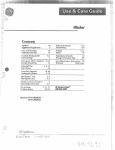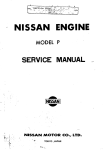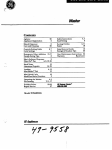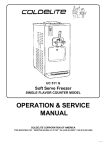Download Coldelite UC-113G/B Technical data
Transcript
Technology For A Sweeter World Counter Model UC-113G Floor Model UF-203G Floor Model UF-253G Gravity Soft Serve Freezers CONDENSED ROUTINE, PERIODIC CLEANING PROCEDURES COLDELITE CORPORATION OF AMERICA COLDELITE BLDG. ROBINSON RD. AT ROUTE 17 SOUTH LODI, N.J. 07644 TEL. (201)843-7400 PART I CLEANING PROCEDURES 3) Place a container or bucket under the spigot head. Slowly pull the handle down and remove remaining product from the cylinder. Cleaning and sanitizing schedules are governed by your State or local regulatory agencies and must be followed accordingly. A well planned cleaning schedule will eliminate excessive waste of time and product within your organization. On a designated day(s) of the week, allow the mix in the mix tank t o run as low as feasible. Proceed t o clean the machine, as follows: 1) Remove the Gravity Feed Tubes. Pull the tubes straight up and out. 4) When the product has stopped flowing, turn the Selector Switch to the OFF position. Close the spigot handle. 2) Turn the Selector Switch to BEATER position and let the machine run for 4 t o 5 minutes. This will soften the product in the cylinder and allow the remaining product to be removed more easily. 5 ) Fill hopper@)and cylinder(s) with cold water (a mild, nonfoaming dish washing detergent is recommended). 7) Brush all surface areas, with brushes provided, to remove all mix particles. 8) Drain Water: 6) Turn Selector Switch to the BEATER position for one minute. Turn Selector Switch to OFF position, drain water by opening the spigot handle. Repeat this process until water is clear. IMPORTANT: Operate unit only in the BEATER position when cleaning. Do not operate unit for excessive periods in the BEATER position, one minute intervals per rinse is recommended. 9) The Gravity Tubes must now be disassembled. To disassemble, first remove the "SPLASH GUARD" by pulling it out of the tube. 10) Next, remove the gravity tube "SLEEVE" by pulling it straight off of the tube. 13) Loosen and remove the four (4) dispensing head retaining knobs. The knobs are removed by turning in a counterclockwise direction. 11) Finally, remove the o-rings using the O-RING EXTRACTOR included in the "start-up kit". 14) Remove the dispensing head by pulling it straight towards you and away from the machine. warnings Never use anything other than the O-RING EXTRACTOR to remove o-rings as damage to the o-ring and/or part can result 12) Remove the two mix level "floats" by lifting them off the stainless steel shaft. 15) Disassemble the dispensing head by first opening all the dispense handles. 18) Using the O-RING EXTRACTOR, remove the piston o-rings Each piston O-ring groove is notched for easy insertion of the o-rina extractor. 19) Turn the dispensing head over and remove the two large 0 rinas from the back of the head. 16) Pull the handle retaining rod out far enough to allow the first handle to disengage. 20) Remove the beater/augers from the freezer cylinders. Pull the beaters STRAIGHT out towards you. Should they become jammed, DO NOT FORCE. Tap the,front of the beater back into the cylinder with the palm of your hand. 17) Return the retaining rod to its orig~nalposition. Using the rod as a fulcrum, lever the dispense piston out of the dispense head with the handle. Repeat this process for each of the three pistons. 21) Disassemble the beater/auger by first removing the rubber beater shaft (lip) seal, simply slide it off the shaft. 25) Wash all the parts in luke warm water (80" - 85'F) using a mild detergent and the cleaning brushes provided in the START-UP KIT. DO NOT USE HOT WATER O N ANY OF THE PLASTIC PARTS AS DAMAGE TO THE PARTS CAN RESULT. 41 Alr Dry 3' San'tlze 22) Continue disassembly by removing the beater IDLER. Pull forward until the grooved portion of the shaft lines up with the opening at the front of the beater/auger. Lift the idler up and out. n \ t Figure 10 26) Rinse the parts in luke warm water (80 - 85 F) 27) Place the parts in luke warm, sanitized water for 2 to 5 minutes. Use the sanitizer provided In the START-UP KIT following the manufacturers directions. 23) Finally, remove the beaterlauger END PUSHER by pulling straight and away from the beater. 24) The machine is now completely disassembled. The parts should now be washed, rinsed and sanitized. 28) Place the parts on a clean, sanitized counter area and allow to air dry or assemble wet. DO NOT TOWEL DRY OR RINSE SANITIZED PARTS. PART I1 ASSEMBLING THE FREEZER Push the idler back, inserting its shaft into the hole of the beaterlauaer shaft. Once the parts have been washed, rinsed and sanitized, the freezer is ready to be re-assembled. Prior to beginning the reassembly procedure, sanitize your hands by submerging in the sanitizing solution. Begin to re-assemble as follows: A) Assembling the Beater/Augers 1) First, re-assemble the beater/auger assembly. Begin by gathering the four parts needed to complete each assembly: A) plastic "END PUSHER", B) BEATERIAUGER, C) IDLER, D) rubber, beater LIP SEAL. When installed correctly, the idler (when turned) should rotate freely. If the idler does not rotate, it is incorrectly installed and must not be installed into the machine. Repeat the above instructions. 4) Next, lubricate and install the beater lip seal by first lubricating the beaterlauger shaft with the lubricant included in the START-UP KIT. Place three, 114" beads in equal distances around the shaft as shown below. Sl~dethe rubber, beater Ilp seal onto the shaft. 2) Al~qninsthe end-pusher slot w ~ t hthe slotted shaft located at the-froit of the beater/auger, slide the end pusher onto the 3 ) Next, install the idler. Holding the idler in a horizontal position, turn the idler until the fins are in an upright position. Then insert the idler by aligning the thinner portion of the Lubricate the end of the beater lip seal which is not lubricated by placing three, 114" beads in equal distances around the seal surface as shown below. 5) Repeat the above procedure for the second beaterlauger assembly. Rotate the beater/auger until you feel the drive shaft engage 6) Finally, insert the beaterlauger into the freezer cylinder. Halding the beaterlauger horizontally, slide it straight into the cylinder until it can go no further. IMPORTANT: Before installing the beaterlauger, make certain the beater lip seal is in place and the idler is properly 7) Insert the second beaterlauger. Once installed, make certain the flat portion of the idler is in a vertical position. The idlers should spin freely and are counter weighted to naturally rest in a vertical position. B) Assembling the Dispensing Head 1) Begin by gathering all the parts necessary to assemble the dispensing head. These parts include: A) two (2),4" diameter O-rings, B) the dispending head<body,C) the center piston O-ring, D) four (4), 13/d' diameter end piston O-rings, E) center piston, F) two (2) end pistons, G) handle retaining rod. H) three (3) dispense handles. 2) First, remount the end piston O-rings onto the end pistons. Simply roll onto the piston until they drop into the O-ring notches. 5) Insert the two end pistons into the two end chambers of the dispensing head body making certain to align the square notch of the piston with the rectangular notch at the front of the dispense head. Repeat this process with center piston and center chamber. 3) Remount the center piston O-ring onto the center piston. This O-ring and piston are easily identified as they appear to b e two O-rings and O-ring grooves interconnected by two vertical posts. 6) Turn the dispense head over and install the two 4" diameter O-rings into O-ring grooves located in the back of the head. 4) Once the O-rings have been mounted, liberally lubricate the area between the two O-rings. Place a bead of lubricant around the entire piston as shown. Lightly lubricate the O-rings with the sanitary lubricant. Spread the lubricant on the surface area between the two O-rings and the O-rings as well. This will ensure free movement of the dispense handles once the head is completely assembled. 7) Affix the dispensing head t o the machine. Lift the front micro switch activating lever and slide the dispensing head onto the four mounting studs. Release the activating lever, the lever should rest vertically atop the pistons. 8) Install the dispensing handles. Insert the round lobe of the handle cam into the square notch of the piston. Slide the retaining rod through the dispense head and cam hole to secure. 10) HAND TIGHTEN the knobs in a criss-cross manner as shown below. C) Assembling the Gravity Feed Tubes 1) Begin by gathering the parts needed to assemble the gravity feed tubes. These parts include: A) the SPLASH GUARD, B) two (2) 314" diameter O-rings, C) the TUBE SLEEVE, and D) the GRAVITY FEED TUBE. 2) Slide the two (2) 314" O-rings onto the bottom of the gravity feed tube until they drop in the O-rings grooves. 9) Fasten the dispense head t o the machine using the four (4) stainless steel retaining knobs. 3) Slide the sleeve onto the tube. Please note that the slots in the sleeve should be at the top of the tube when installed. 7) Install the two (2) mix level floats by simply sliding one each onto the stainless steel shaft in the mix tank. 4) Slide the splash guard into the tube. The machine is now completely assembled and ready to be sanitized. PART Ill SANITIZING THE FREEZER 5) Lubricate the two O-rings with sanitary lubricant. Prior to starting the machine with your soft serve product, the machine must be sanitized. The frequency of cleanina and - .sanitizing cycles must comply with local health regulations. If uncertain about local regulations, contact your local Board of Health. - Sanitizing the machine is most important. This procedure will retard the growth of bacteria and insure excellent test results on your product when examined by local Health and/or Agriculture Departments. 6) Insert the assembled tubes into the hole at the bottom of the mix tank. Press the tube down until it seats and the flange at the base of the tube rests against the bottom of the mix tank. To begin, you will need a clean pail, sanitizer (sample packets included in the start-up kit), spatula (included in start-up kit), and brush (plastic bristle). %$ 1) Mix the san~tlzer(2 ounces of Steera Sheen green label or equ~valent)Into a clean pall c o n t a ~ n ~ ntwo g gallons of warm water. T h ~ ssolut~onwill make a 200 P.P.M (parts per rnllllon) concentration of chlorlne sanitmng solut~onPour the ~ o l u t l 0 n into t h e mlx tanks. 4) Turn the selector swltch to the "OFF" pos~t~on. ENERGYCONS 5) Using a sanitized soft bristle brush, brush the sides of the mix tank, and all other product contact areas. Allow the sanitizing solution to remain in contact with all product contact areas for three to five minutes. IMPORTANT: Do not exceed the formula recommended b y the sanitizer manufacturer as i t will not add to its effectiveness. 2) Pull the gravity feed tubes out of the mix tank holes and lay them down in the tank. This will allow the cylinders to c o m ~ l e t e l yfill with the sanitizing solution. 6) Place the clean, sanitized pail under the dispensing head and open the handles by pulling them in a downward direction. 3) Turn the selector switch to the "BEATER" position for 30 seconds. 7) Allow the sanitizer to completely drain. Close handles. 2) Rest the gravity feed tubes upright against the side of mix tank as shown. 3) Pour ll/z pints of mix into each mix tank. Allow the mix to drain into the freezer cylinders. This will properly "prime" each cylinder. HELPFUL SUGGESTION: When the sanitizer stops flowing, leave the handles open and turn the selector switch to the "BEATER" position for two to three seconds to help remove the last of the sanitizer. CAUTION: We recommend the beater/auger be turned as little as possible during the washing and sanitizing operations. Excessive use will cause premature wear to the beater/auger and cylinders. PART IV STARTING THE FREEZER Only after the machine has been thoroughly cleaned and sanitized is the unit ready for production. Start the machine as follows: 1) Pour 1 % pints of liquid mix (soft serve ice cream, ice milk, frozen yogurt, dietary or non-dairy mix) into a clean, sanitized measuring container. SUGGESTION: When initially pouring mix into the tank, it is recommended the dispense handles be opened to allow any residual sanitizer to be "chased" out by the mix entering the cylinders. Place a cup under the dispense head to catch any residual sanitizer, 2 - 3 oz. is sufficient to purge the sanitizer out. 4) Once the pre-measured 1% pints of mix has completely drained into the freezing cylinders, insert the gravity feed tubes into the holes at the bottom of the mix tank. Make certain the hole at the top of sleeve and tube are facing toward the front of the machine and are visible. 5 ) Turn the adjustment sleeve of the aravity until the medium sized hole for moderate production-is aligned with the hole in the gravity feed tube. A+i: Mlnlmum Production Moderaie Productton Maxlmum Production 7 )Turn the selector switch to the "AUTO" position. Energy conservation Figure 12 Gravity Feed Tube Adjustment Settings 6) Fill the tanks w ~ t hmix. Total capacity is two (2) gallons each. Never fill the tanks higher than the bottom of the slots in the gravity feed tube sleeve. 8) Initial freeze-down of the product will take 7 - 1 0 minutes dependent on the type of product being frozen. PART V OPERATING THE FREEZER The machine will automatically shut-off when the product has been frozen to the pre-set "consistency". After the 7-10 minute initial freeze-down period, you will hear the beaterlauger drive motor shut down indicating the product is ready t o be served. The compressor will continue to run for a short period as the machine automatically directs refrigeration to the mix tanks immediately after the freeze-down cycle. To serve, simply place a cup, container or cone under the dispensing spout and slowly pull the dispensing handle down. As the product begins to flow, move the cup or cone in a circular fashion to create a tapering tower. Max FIII Level - Figure d 1 When the portion is the size you want, close the handle and pull the cup or cone straight down to add a peak. The outer tube is actually a valve. Rotating it from hole to hole on the outer tube varies the size of the hole and the amount of mix that flows into the freezing cylinder. The size of the alr inlet, at the top of the tube, does not change so the amount of air that enters the freezing cylinder is constant. You can vary the overrun (yield) by letting more or less mix enter the freezing cyl~nderby manually regulating the valve. You must align the mix inlet holes on both the inner and outer tubes or no mix will enter the cylinder. You can see this hole at the top of both tubes. See illustration below. Figure 1 2 Gravity Feed Tube Adjustment Settings Typical portion sizes are: SMALL = 3 OUNCE SERVING MEDIUM = 5 OUNCE SERVING LARGE = 7 OUNCE SERVING Gravity Feed Valve - HOWto Operate and Make Adjustments The Gravity Feed Valve consists of two tubes. one slid~rlginside the other, and a plungerlsplash guard. The inner tube blends the flow of air and mix into the freezing cylinder. Air enters through the top of the tube and the mlx. through a round hole at the base. See illustration below The plunger/splash guard keeps the mix from splashing on the mix tank cover and serves as a device to eliminate potent~al clogging inside the tubes You may find it necessary to.adjust the position of the outer tube in order to regulate the amount of mix entering the freezing cylinder after start-up. Actually, sales conditions will dictate the proper adjustment. If more production is required, increase the opening by rotating the outer tube to a laraer - hole, and converselv when business is slow, rotate to a smaller hole on the outer tube, reducing the opening. Naturally, when the mix runs low in the mix tank, you will open the slot more and eventually take the feed tube out completely to use the last of mix in the mix tank. Energy Conservation During long idle periods. it is recammended the outer sleeve of the gravity feed tube be rotated to the position which closes the mix intake hole completely. IMPORTANT. Remember to rotate the outer tube to the appropriate opening Sefore switching to the AUTO mode. For further Operational or Technical Data, please refer to the "Operation and Service Manual" or contact your authorized Coldelite Distributor or Service Agency. All technical data, pictures and drawings contained in this leaflet are not binding on the manufacturer; nor can the manufacturer be held liable for any modification of the machine in part or completely. dL Figure 11 .,

















